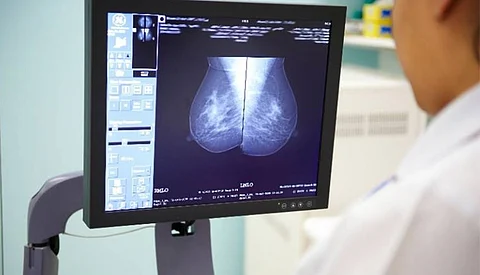

A breast cancer therapy which requires just one shot of radiotherapy rather than conventional weeks-long treatment holds out worldwide promise after it was found to be effective in a long-term study led by a Global Indian oncologist.
Professor Jayant Vaidya, Professor of Surgery and Oncology at University College London (UCL) Surgery & Interventional Science and lead author of the study published in the 'British Medical Journal' this week, said the Targeted Intraoperative Radiotherapy (TARGIT-IORT) means a quicker recovery period from breast cancer and his team's findings should pave the way for it to be more widely available. Under the technique developed by UCL clinicians,radiotherapy is administered from inside the body?via a small ball-shaped device placed inside the breast and immediately after a tumour is removed (lumpectomy) while the patient is still under anaesthetic.
Prof. Vaidya explains: “With TARGIT-IORT, women can have their surgery and radiation treatment for breast cancer all at the same time.
“This reduces the amount of time spent in hospital and enables women to recover more quickly, meaning they can get back to their lives more quickly.With publication of these very positive long-term results, it is now clear that this treatment should be made much more freely available. It should be accessible to healthcare providers and discussed with patients when surgery for breast cancer is being planned.”
The TARGIT-IORT technique was developed by Vaidya along with fellow UCL clinical academics Professor Jeffrey S.Tobias and?Professor Michael Baum, in 1998 in collaboration with the manufacturers.
The single-dose treatment lasts for around 20 to 30 minutes and replaces the need for extra hospital visits, benefiting both patient safety and well-being, the experts highlight.
“These results are the highest level of evidence proving not only the effectiveness of TARGIT-IORT but confirming that it avoids deaths from other causes. I am pleased that it will benefit thousands of breast cancer patients around the world,” said co-author Professor Michael Baum from UCL Surgery & Interventional Science.
Conventional external beam radiotherapy (EBRT) is delivered from outside the body via a radiotherapy machine (linear accelerator), and consists of a daily treatment session (known as fractions) to the whole breast, over a period between three to six weeks. Each of these treatments is given over a few minutes, but requires 15 to 30 hospital visits, which could be a significant distance from where the patient lives.
To establish TARGIT-IORT's long-term effectiveness, 2,298 women aged 45 or over with invasive ductal carcinoma (breast cancer) and a tumour of up to 3.5cm in size, were randomly assigned to receive either TARGIT-IORT or the traditional EBRT.This large clinical trial, designed and run from UCL, involved 32 hospitals and medical centres in 10 countries: the UK, France, Germany, Italy, Norway, Poland, Switzerland, United States, Canada and Australia. The trial started in March 2000, with researchers publishing its long-term results this week.
“With TARGIT-IORT, a large proportion of patients with breast cancer will never need to make the repeated daily visits to the radiotherapy centre. They avoid side effects of whole breast radiotherapy. Importantly, TARGIT-IORT reduces the burden on overstretched radiotherapy departments,” said co-author Professor Jeffrey S. Tobias, Professor of Clinical Oncology, UCL & UCLH [University College London Hospitals].
The latest findings show that with TARGIT-IORT therapy, eight out of every 10 patients had no need for any further post-operative radiotherapy treatments. There was also no detriment to survival and no increase in the likelihood of the cancer returning.
In addition, with TARGIT-IORT, significantly fewer women died from causes other than breast cancer. Previous studies have shown that TARGIT-IORT has fewer radiation-related side effects compared with conventional whole breast radiotherapy, with less pain, better cosmetic outcome and a better quality of life.
During the past 20 years this method has been used worldwide in over 260 medical health centres in 38 countries, helping to treat?more than 45,000 patients. Funding for the trial was provided by the UK's National Institute for Health Research (NIHR) Health Technology Assessment programme, UCL Comprehensive Biomedical Research Centre, and Cancer Research UK.
by Nadia Hatink